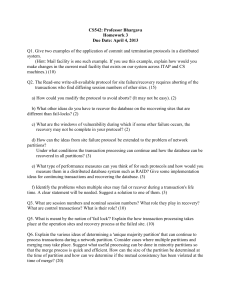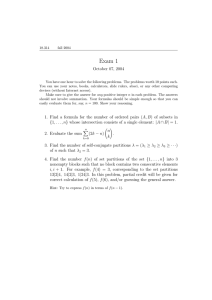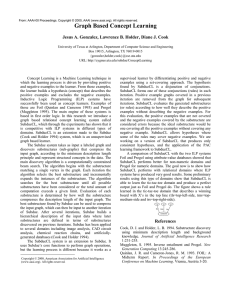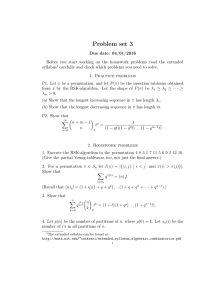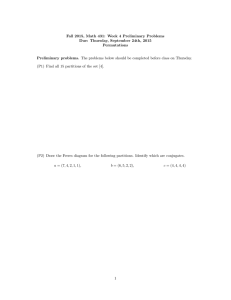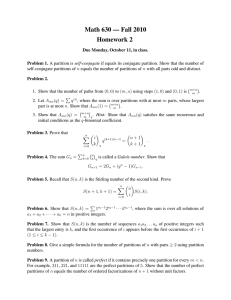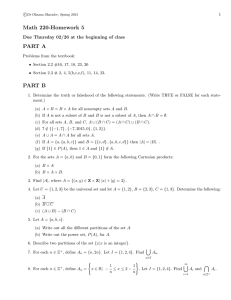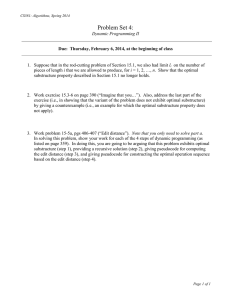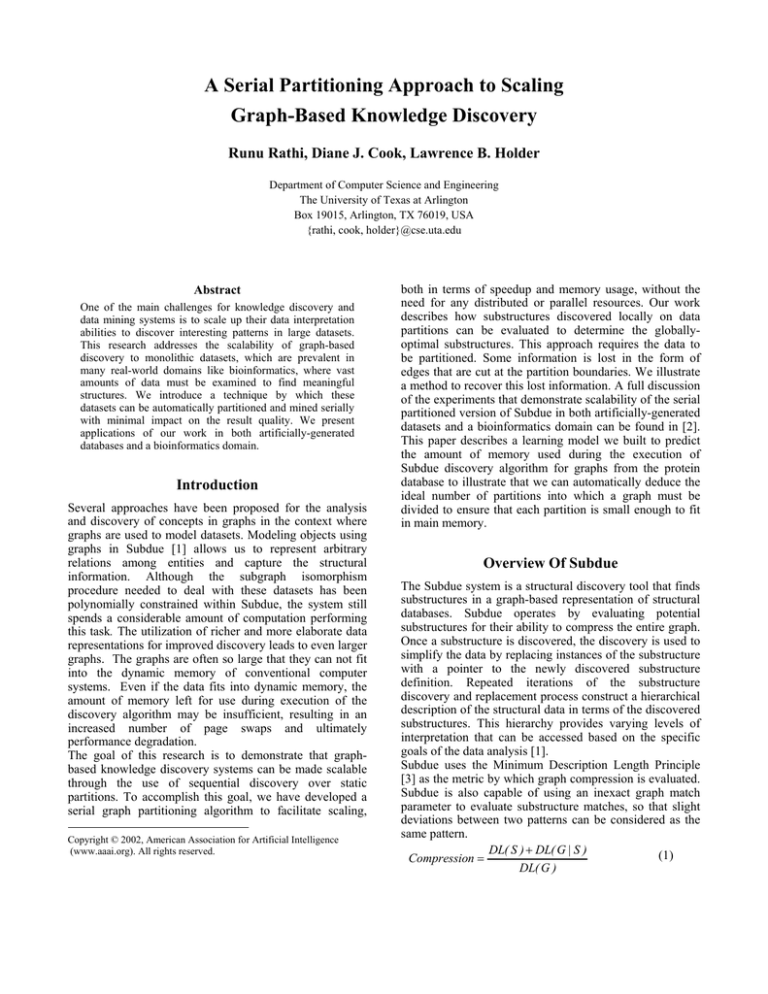
A Serial Partitioning Approach to Scaling
Graph-Based Knowledge Discovery
Runu Rathi, Diane J. Cook, Lawrence B. Holder
Department of Computer Science and Engineering
The University of Texas at Arlington
Box 19015, Arlington, TX 76019, USA
{rathi, cook, holder}@cse.uta.edu
Abstract
One of the main challenges for knowledge discovery and
data mining systems is to scale up their data interpretation
abilities to discover interesting patterns in large datasets.
This research addresses the scalability of graph-based
discovery to monolithic datasets, which are prevalent in
many real-world domains like bioinformatics, where vast
amounts of data must be examined to find meaningful
structures. We introduce a technique by which these
datasets can be automatically partitioned and mined serially
with minimal impact on the result quality. We present
applications of our work in both artificially-generated
databases and a bioinformatics domain.
Introduction
Several approaches have been proposed for the analysis
and discovery of concepts in graphs in the context where
graphs are used to model datasets. Modeling objects using
graphs in Subdue [1] allows us to represent arbitrary
relations among entities and capture the structural
information. Although the subgraph isomorphism
procedure needed to deal with these datasets has been
polynomially constrained within Subdue, the system still
spends a considerable amount of computation performing
this task. The utilization of richer and more elaborate data
representations for improved discovery leads to even larger
graphs. The graphs are often so large that they can not fit
into the dynamic memory of conventional computer
systems. Even if the data fits into dynamic memory, the
amount of memory left for use during execution of the
discovery algorithm may be insufficient, resulting in an
increased number of page swaps and ultimately
performance degradation.
The goal of this research is to demonstrate that graphbased knowledge discovery systems can be made scalable
through the use of sequential discovery over static
partitions. To accomplish this goal, we have developed a
serial graph partitioning algorithm to facilitate scaling,
Copyright © 2002, American Association for Artificial Intelligence
(www.aaai.org). All rights reserved.
both in terms of speedup and memory usage, without the
need for any distributed or parallel resources. Our work
describes how substructures discovered locally on data
partitions can be evaluated to determine the globallyoptimal substructures. This approach requires the data to
be partitioned. Some information is lost in the form of
edges that are cut at the partition boundaries. We illustrate
a method to recover this lost information. A full discussion
of the experiments that demonstrate scalability of the serial
partitioned version of Subdue in both artificially-generated
datasets and a bioinformatics domain can be found in [2].
This paper describes a learning model we built to predict
the amount of memory used during the execution of
Subdue discovery algorithm for graphs from the protein
database to illustrate that we can automatically deduce the
ideal number of partitions into which a graph must be
divided to ensure that each partition is small enough to fit
in main memory.
Overview Of Subdue
The Subdue system is a structural discovery tool that finds
substructures in a graph-based representation of structural
databases. Subdue operates by evaluating potential
substructures for their ability to compress the entire graph.
Once a substructure is discovered, the discovery is used to
simplify the data by replacing instances of the substructure
with a pointer to the newly discovered substructure
definition. Repeated iterations of the substructure
discovery and replacement process construct a hierarchical
description of the structural data in terms of the discovered
substructures. This hierarchy provides varying levels of
interpretation that can be accessed based on the specific
goals of the data analysis [1].
Subdue uses the Minimum Description Length Principle
[3] as the metric by which graph compression is evaluated.
Subdue is also capable of using an inexact graph match
parameter to evaluate substructure matches, so that slight
deviations between two patterns can be considered as the
same pattern.
DL( S ) + DL( G | S )
(1)
Compression =
DL( G )
Equation 1 illustrates the compression equation used to
evaluate substructures, where DL(S) is the description
length of the substructure being evaluated, DL(G|S) is the
description length of the graph as compressed by the
substructure, and DL(G) is the description length of the
original graph. The better a substructure performs, the
smaller the compression ratio will be.
Related Work
Related partitioning and sampling approaches have been
proposed for scaling other types of data mining algorithms
to large databases. The partition algorithm [4] makes two
passes over an input transaction database to generate
association rules. The database is divided into nonoverlapping partitions and each of the partitions is mined
individually to generate local frequent itemsets. We adapt
some of the ideas of the partition algorithm to graph-based
data mining. However, generally the graph cannot be
divided into non-overlapping partitions as in the partition
algorithm for generating association rules. The edges cut at
the partition boundaries pose a challenge to the quality of
discovery. The turbo-charging vertical mining algorithm
[5] incorporates the concept of data compression to boost
the performance of the mining algorithm. The FP-Tree
algorithm [6] builds a special tree structure in main
memory to avoid multiple passes over database. In an
alternative approach, the sampling algorithm [7] picks a
random sample to find all association rules that with high
probability apply to the entire database, and then verifies
the results with the rest of the database.
//Invoke serial Subdue on each partition Gj, which
//returns top b substructures for the jth partition
for each partition Gj
localBest[] = Subdue(Gj);
//Store local best substructures for global evaluation
bestSubstructures[] =
Union(bestSubstructures[],localBest[]);
--------------------------------------------------------------------------//Reevaluate each locally-best substructure on all
//partitions
sizeOfGraph = 0;
for each substructure Si in bestSubstructures[]
sizeOfSubSi = MDL(Si);
sizeCompressedGraph = 0; //initialize
for each partition Gj
//size of graph (in bits) is the sum of sizes of
//individual partitions
sizeCompressedGraph =
sizeCompressedGraph + MDL(Gj|Si);
sizeOfGraph = sizeOfGraph + MDL(Gj);
//Calculate global value of substructure
subValueSi = sizeOfGraph / (sizeOfSubSi +
sizeCompressedGraph);
bestSubstructures[i].globalValue = subValueSi;
//Return the top b substructures in bestSubstructures[]
//as the top b global best substructures
Figure 1. SSP-Subdue Algorithm
In earlier work, a static partitioning algorithm was
introduced [8] to scale the Subdue graph-based data
mining algorithm using distributed processing. This type of
parallelism is appealing in terms of memory usage and
speedup. The input graph is partitioned into n partitions for
n processors. Each processor performs Subdue on its local
graph partition and broadcasts its best substructures to the
other processors. A master processor gathers the results
and determines the global best discoveries. However, this
approach requires a network of workstations using
communication software such as PVM or MPI. The
knowledge discovered by each processor needs to be
communicated to other processors. Our serial partitioning
approach, implemented in the SSP-Subdue system, is
unaffected by the communication problems of a distributed
cluster as the partitions are mined one after the other on a
single machine with the same processor playing the roles
of slave and master processors in the static partitioning
approach.
Serial Static Partitioning Using SSP-Subdue
We have developed an algorithm that operates serially on
smaller partitions of the graph and then compares the local
results to acquire a measure of the overall best
substructures for the entire graph.
The input graph is partitioned into x partitions. We
perform Subdue on each partition and collect the b best
substructures local to each partition in a list, where b is the
beam used to constrain the number of best substructures
reported. We take care that for each partition, Subdue
reports only the substructures that have not already been
reported as locally-best on any of the previously-processed
partitions. By doing so, we implicitly increase the beam
dynamically. At the end of this pass, there are xb
substructures in the list. Then we evaluate these xb locallybest substructures on all partitions in a second pass over
the static partitions, similar to the partition approach
applied to association rule mining [3]. Once all evaluations
are complete, we gather the results and determine the
global best discoveries. This is a serial approach and does
not rely on parallel hardware. Figure 1 summarizes the
basic algorithm.
Compressio nRatio j (S ) =
DL ( S ) + DL (G j | S )
DL (G j )
(2 )
As a part of this research, we have generated a variant of
the MDL measure, which is used to rank discoveries
globally. SSP-Subdue measures graph compression using
our measure variant given in Equation 2, where DL(S) is
the description length of the substructure S being
evaluated, DL(Gj|S) is the description length of the graph
corresponding to the jth partition as compressed by
substructure S, and DL(Gj) is the description length of the
uncompressed jth partition. The substructure that
minimizes the sum of DL(S) and DL(Gj|S) is the most
descriptive substructure, and thus is locally the best. The
smaller the value of the compression ratio of a
square
below
ellipse
square
below
below
circle
ellipse
near
ellipse
ellipse
ellipse
near
below
below
circle
circle
below
below
near
square
circle
circle
square
ellipse
rectangle
circle
below
below
near
circle
triangle
rectangle
below
Figure 3. Local best substructures of partition 1
triangle
Figure 2. Partition 1
below
square
below
rectangle
square
circle
below
below
near
triangle
rectangle
rectangle
below
below
triangle
triangle
near
rectangle
circle
below
below
trangle
ellipse
near
triangle
Figure 6. Global best substructures
rectangle
below
below
circle
triangle
Figure 5. Local best substructures of partition 2
Figure 4. Partition 2
substructure, the higher will Subdue rank that substructure
locally for the jth partition.
The global best substructures are found by reevaluating the
locally best substructures using Equation 3 on the other
partitions. Here, S is a substructure in the common list. The
common list represents a collection of all local best
substructures. The variable x represents the number of
partitions, DL(S) is the description length of the
substructure S under consideration, ∑x j=1DL(Gj|S) is the
sum of description lengths of all the partitions after being
compressed by the substructure S, and ∑x j=1DL(Gj) is the
description length of the entire graph. The substructure
with the minimum value of the compression ratio obtained
from Equation 3 is ranked as globally the best
substructure.
x
DL( S ) +
Compression( S ) =
∑ DL(G | S )
j
j =1
x
∑ DL(G )
(3)
j
j =1
The following example illustrates the SSP-Subdue
algorithm concepts. For this example input graph is split
into two partitions. Subdue is run on partition 1 shown in
Figure 2 and the best substructures local to this partition,
shown in Figure 3, are stored for global evaluation. Next,
Subdue is run on partition 2 shown in Figure 4 and the best
substructures local to this partition, shown in Figure 5, are
stored for global evaluation. In a second pass over both of
the static partitions, all of the locally-best substructures are
evaluated using Equation 3 to produce the globally-best
substructures shown in Figure 6. The instances of these
globally best substructures are highlighted in the two
partitions.
Edge-loss Recovery Approach
The partitions are compressed using the globally best
substructures found by running SSP-Subdue and then
combined in pairs. Then the edges that were lost due to the
original partitioning are reinserted between the combined
partitions.
Since merging all possible combinations of two partitions
that have edges cut between them could lead to a total of
x(x-1)/2 combinations, each partition is constrained to be
combined at most once with another partition. The pair of
partitions that have the maximum number of edges cut
between them are merged. Then the pair of partitions that
have the second maximum number of edges cut between
them are combined, and so on. This guarantees that two
partitions are not combined unless they had any edges cut
between them. However, this might sometimes lead to a
matching such that some partitions are left that cannot be
combined with any of the remaining unpaired partitions
due to no edges cut at the boundaries. Here we are
assuming that the compression and combining of partitions
will not lead to a partition with a size too large to fit in
dynamic memory. Finally, SSP-Subdue is executed on the
combined partitions to get the globally-best substructures.
The following example illustrates our approach. The input
graph, showsn in Figure 7, is divided into two parts. As a
result of this partitioning, all the instances of one of the
most frequently occurring substructures, “rectangle below
triangle”, are lost. After running SSP-Subdue on the
partitions shown in Figure 8, the substructures illustrated
in Figure 9 are reported as the global best substructures.
The two partitions are compressed using the above
substructures and combined to form the graph shown in
Figure 10. After running SSP-Subdue on the compressed
graph shown in Figure 10, the substructures in Figure 11
were reported as the best substructures. Clearly this set
includes larger substructures encompassing the frequentlyoccurring substructure, “rectangle below triangle,” which
was initially lost due to the original partitioning. Thus, this
approach proves useful in recovering the instances of those
interesting substructures that are lost due to the original
partitioning. However, a problem can occur when the best
substructure is broken across partition boundaries, and
subgraphs within this substructure are discovered in local
partitions in different combinations with other subgraphs.
The local discoveries would be used to compress the
partitions and the original substructure will not be
reformed and discovered in the second iteration. To remain
consistent with the original Subdue algorithm, the
compression could be performed using only the single best
substructure found as opposed to the beam number of best
substructures. Then the compressed subgraph would still
appear as part of the original substructure and the best
could be found.
Learning Model to Deduce Number of
Partitions
Np, the ideal number of partitions for a given graph, is an
important parameter for SSP-Subdue that affects the
quality of discovery as well as the run time. As a result, the
user would benefit from receiving a suggested value of Np
from the system.
Motivation for Employing a Learning Model
The mechanism to find Np should be independent of the
different versions and implementations of Subdue. Since
Subdue is a main memory algorithm, Np depends on the
amount of memory available for it to use during execution
of the discovery algorithm after loading the input graph in
memory. The amount of memory used during the
execution of the discovery algorithm (Mused) is not a
straightforward function of the size of the graph. It
depends on several other factors directly related to the
structure of the graph and those specific to Subdue’s
parameters used to constrain the search for interesting
patterns in the input graph. Thus, the mechanism to deduce
Mused, and in turn Np, should be powerful enough to deduce
the values based on all of the above factors.
Also, the actual amount of memory that a process is
allowed to use (Mmax) is not necessarily equal to the
amount of main memory available on a machine. It is in
fact dependent on various other factors like number of
square
square
near
circle
near
ellipse
rectangl
below
rectangl
triangl
below
triangl
triangl
below
ellipse
below
ellipse
below
near
rectangl
circle
below
rectangl
ellipse
below
triangl
below
near
ellipse
rectangl
rectangl
below
below
ellipse
triangl
below
near
below
rectangl
below
circle
rectangl
below
ellipse
near
near
below
ellipse
SUB_2_1
rectangl
circle
below
below
SUB_2_3
triangl
triangle
below
near
rectangl
circle
SUB_2_2
ellipse
below
ellipse
circle
below
square
rectangl
rectangl
rectangl
below
triangl
Figure 8. Partition 1 and 2 of graph G'
ellipse
below
rectangl
below
rectangl
Figure 7. Unpartitioned graph G'
ellipse
SUB_2_4
SUB_2_5
SUB_2_6
Figure 9. Global best substructures after first pass
square
near
circle
ellipse
near
near
ellipse
below
ellipse
ellipse
below
rectangl
near
below
rectangl
below
rectangl
circle
rectangl
Figure 11. Global best substructures
below
rectangl
near
below
triangl
below
SUB_2_2
ellipse
below
SUB_2_2
SUB_2_1
below
SUB_2_5
square
below
Figure 10. Compressed graph
below
rectangl
below
SUB_2_5
below
ellipse
processors running at a given time, the amount of main
memory used by the operating system resident files and
other limits and operating system parameters configured at
the time of system installation and administration. Thus, it
is unreasonable to consider a fixed value for Mmax.
Our goal is to predict the memory usage for any given
graph when run with any combination of Subdue-specific
parameters to aid in deducing the optimal number of
partitions for that graph. We hypothesized that we could
build a learning model to predict the amount of memory
used (Mused) during the execution of the Subdue discovery
algorithm for a graph provided the learning model is
trained with enough training example graphs from a
particular domain. The value of Mused could then be used to
calculate Np, the ideal number of partitions for a given
graph. We successfully validated our hypothesis for a
constrained case by experimenting with graphs from a
particular domain.
The Approach
Let param1…paramN represent the various parameters
that govern the amount of memory used by Subdue. Then,
we can use training examples with varying values of
(param1…paramN) to build our learning model. This
learning model can be used to predict the value of Mused for
a new graph. If Mused exceeds Mmax, then the graph needs to
be partitioned.
With this new graph a set (param1…paramN, Mmax) is
constructed and input to a similar learning model that can
predict sg, the maximum size of graph that can be
processed with Mmax, the amount of memory available for
use by Subdue discovery algorithm. Now if the original
graph to be partitioned is of size S, then the value of Np,
the number of partitions, can be calculated as S/sg.
We used Weka [9], a data mining software package, to
build our learning model. Mmax can be estimated from the
amount of free memory reported by the ‘free’ command of
the Unix operating system.
Features Influencing Memory Usage
The features related to the structure of the input graph that
influence the memory usage of the discovery algorithm are
total number of vertices, total number of edges, total
number of directed edges, total number of undirected
edges, total number of unique vertex labels, total number
of unique edge labels, variance in degree of vertices or
connectivity, total number of disconnected graphs making
up the input graph and compressive capacity of the best
substructures.
The Subdue parameters that influence the amount of
memory used by the discovery algorithm are the beam
width of Subdue discovery algorithm, the number of
different substructures considered in each iteration of the
Subdue discovery algorithm, the maximum number of
vertices that can exist in a reported substructure, the
minimum number of vertices that can exist in a reported
substructure, the method used for evaluating candidate
substructures, the number of iterations of the Subdue
discovery algorithm that will be executed on the input
graph, the fraction of the size of an instance by which the
instance can be different from the substructure definition.
Varying the above parameters in all different possible
combinations would require a large number of
experimental tests. Besides, in most practical cases, most
of the default Subdue parameters are used or one set of
parameter values is used for all graphs from the same
domain. Hence, we restricted our tests to some of the
features related to the structure of the graph namely
number of vertices and edges, number of directed and
undirected edges, number of unique vertex and edge labels
and variance in degree of vertices while keeping the
Subdue-specific parameters set to their default values.
Further, our initial attempt to learn Subdue’s memory
requirement for a mix of graphs from different domains
showed poor performance (about 15% predictive
accuracy). This indicated that graphs from different
domains are vastly different in their memory requirements
and hence pose a very challenging job for the learning
model. Thus, we restricted our tests to graphs from a single
domain to see if the hypothesis can be validated for a
constrained portion of the whole problem.
Protein Database. The Protein Data Bank (PDB) is a
worldwide repository for processing and distributing 3-D
data structures for large molecules of proteins and nucleic
acids. We converted the information in the given PDB file
to a Subdue-formatted graph file corresponding to the
compound described in the PDB file. Since we were
mainly concerned with experimenting on graphs of varying
sizes, the files from PDB used for our experiments were
selected randomly and inclusion of no particular chemical
compound was emphasized. We browsed the database to
obtain the graphs of the required sizes.
Use of Decision Trees for Prediction
Decision trees represent a supervised approach to
classification. A decision tree is a simple structure where
non-terminal nodes represent tests on one or more
attributes and terminal nodes reflect decision outcomes.
We used Weka to apply the J48 learning method to the
PDB dataset and analyze its output. The J48 algorithm is
Weka’s implementation of the C4.5 decision tree learner.
C4.5 is a landmark system for decision tree induction
devised by Ross Quinlan.
We prefer to use decision trees over other classifiers since
they have a simple representational form, making the
inferred model relatively easy for the user to comprehend.
Other classifiers like neural networks, although a powerful
modeling tool, are relatively difficult to understand
compared to decision trees. Decision trees can classify
both categorical and numerical data, but the output
attribute must be categorical. There are no prior
assumptions made about the nature of the data. However,
decision tree algorithms are unstable. Slight variations in
the training data can result in different attribute selections
at each choice point within the tree. The effect can be
significant since attribute choices affect all descendent
subtrees. Trees created from numeric data sets can be quite
complex since attribute splits for numeric data are binary.
Learning Curve
We randomly chose a set of 60 PDB datasets and
converted them into Subdue-format graph files. All the
relevant information required for populating Weka’s input
file including number of vertices and edges, number of
directed and undirected edges, number of unique vertex
and edge labels, variance in degree of vertices and memory
used for processing was calculated from each of the
graphs. This comprised the training set for our learning
model. The classes defined in the input file were the
memory used for the processing of these graphs by Subdue
(i.e., 1MB, 2MB, 3MB, 4MB, 5MB, 6MB, 8MB, 10MB,
12MB, 14MB, 18MB, and 22MB), resulting in 12 possible
classes. We used a test set comprising of 30 randomlyselected graphs, with random class distribution, from the
training set to evaluate our learning model. On applying
the J48 algorithm to the PDB dataset, the J48 pruned tree
(in text format), built using the training set, was obtained
along with an estimate of the tree’s predictive
performance. The test data derived the performance
statistics. 24 test instances (80%) were classified correctly
and 6 (20%) were misclassified out of a total of 30
instances. In addition, the following measurements were
derived from the class probabilities assigned by the tree.
• Kappa statistic
0.765
• Mean absolute error
0.0347
• Root mean squared error
0.1323
• Relative absolute error
23.9333 %
• Root relative squared error
49.3356 %
A kappa statistic of 0.7 or higher is generally regarded as
good statistic correlation. In all of these error
measurements, a lower value means a more precise model,
with a value of 0 depicting the statistically-perfect model.
Learning Curve. The learning model was trained on
random subsets of varying sizes (5, 10, 15... 55, 60) from
the 60 PDB graphs. A learning curve was plotted by
recording the learning model’s percentage accuracy in
prediction of the memory used by the graphs in the test set
for each such training set. The learning curve, shown in
Figure 12, was found to plateau at 80% predictive
accuracy.
Conclusions
This research proposes an effective solution, in the form of
a serial partitioning approach, to one of the main
challenges for graph-based knowledge discovery and data
mining systems, which is to scale up their data
interpretation abilities to discover interesting patterns in
large datasets without the need of any distributed or
parallel resources. It also illustrates how information lost
in the form of edges that are cut at the partition boundaries
can be recovered and how the optimal number of partitions
into which a graph needs to be divided into can be deduced
automatically.
The performance of the learning model on a constrained
portion of the complete problem was encouraging enough
% Accuracy
Experimental Results
100
80
60
40
20
0
PDB
5
10 15 20 25 30 35 40 45 50 55 60
PDB 17 23 33 30 40 47 57 63 70 77 80 80
Number of training examples
Figure 12. Learning Curve for graphs from PDB with
a test set of 30 graphs.
to conclude that the system could be made to learn to
predict the memory usage for a fresh graph similar to those
it was trained on. One could enhance the model to include
graphs from other domains but since graphs from different
domains are vastly different in their memory requirements,
they pose a very challenging job for the learning model. To
learn a truly generic model, an exhaustive training set
would be required comprising of all types of graphs from
all possible different domains. The learning model will
have better prediction accuracy when trained on graphs
from a single domain since graphs from the same domain
are similar in their memory requirements.
References
[1] D. J. Cook and L. B. Holder, Graph-Based Data Mining,
IEEE Intelligent Systems, 15(2), pages 32-41, 2000.
[2] Coble, J., Rathi, R., Cook, D., Holder, L. Iterative Structure
Discovery in Graph-Based Data. To appear in the
International Journal of Artificial Intelligence Tools, 2005.
[3] Cook, D. and Holder, L. 1994. Substructure Discovery
Using Minimum Description Length and Background
Knowledge. In Journal of Artificial Intelligence Research,
Volume 1, pages 231-255.
[4] Savasere, A., E. Omiecinsky, and S. Navathe. An efficient
algorithm for mining association rules in large databases.
21st Int'l Cong. on Very Large Databases (VLDB). 1995.
Zurich, Switzerland.
[5] Shenoy, P., et al. Turbo-charging Vertical Mining of Large
Databases. ACM SIGMOD Int'l Conference on Management
of Data. 2000. Dallas.
[6] Han, J., J. Pei, and Y. Yin. Mining Frequent Patterns without
Candidate Generation. ACM SIGMOD Int'l Conference on
Management of Data. 2000. Dallas.
[7] Toivonen, H. Sampling Large Databases for Association
Rules. In Proc. 1996 Int. Conf. Very Large Data Bases.
1996: Morgan Kaufman.
[8] D. J. Cook, L. B. Holder, G. Galal, and R. Maglothin,
Approaches to Parallel Graph-Based Knowledge Discovery,
Journal of Parallel and Distributed Computing, 61(3), pages
427-446, 2001.
[9] Ian H. Witten and Eibe Frank, Data Mining: Practical
Machine Learning Tools with Java Implementations,
Morgan Kaufmann, San Francisco, 2000.

